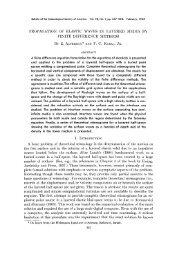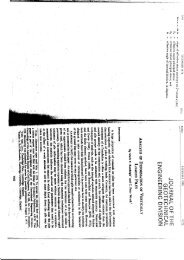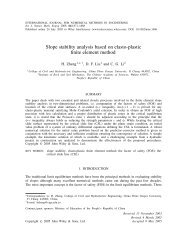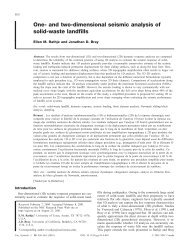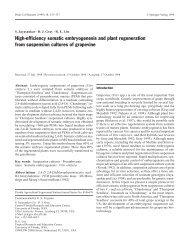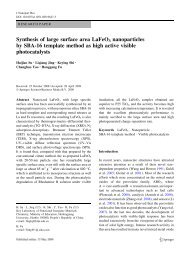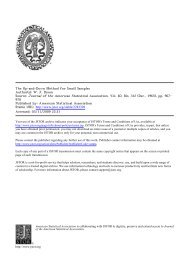Design and Synthesis of AX7574: A Microcystin-Derived ...
Design and Synthesis of AX7574: A Microcystin-Derived ...
Design and Synthesis of AX7574: A Microcystin-Derived ...
You also want an ePaper? Increase the reach of your titles
YUMPU automatically turns print PDFs into web optimized ePapers that Google loves.
796 Bioconjugate Chem., Vol. 15, No. 4, 2004 Shreder et al.Downloaded by WUHAN UNIV on October 25, 2009 | http://pubs.acs.orgPublication Date (Web): June 18, 2004 | doi: 10.1021/bc0499580Figure 6. <strong>AX7574</strong> can detect serine/threonine phosphatases in a proteome. (A) Soluble proteome derived from Jurkat cellspreincubated with or without microcystin (1 µM) or calyculin a (1 µM) for 10 min <strong>and</strong> then treated with <strong>AX7574</strong> (0.5 µM) for 60 min.Reactions were quenched with st<strong>and</strong>ard 2× SDS/PAGE loading buffer (reducing), separated from unreacted <strong>AX7574</strong> using SDS-PAGE, <strong>and</strong> visualized in-gel using a flatbed laser-induced fluorescence scanner. (B) Coomassie blue stained gel from Figure 6Aconfirming that all three lanes contained approximately equal amounts <strong>of</strong> protein. (C) <strong>AX7574</strong>-labeled proteins identified using MSprotein identification.Figure 7. <strong>AX7574</strong> can detect the decrease <strong>of</strong> serine/threonine protein phosphatase activities in calyculin A-treated Jurkat T cells.(A) Jurkat cells treated with calyculin A (25 nM) for 60 min or control DMSO, <strong>and</strong> soluble proteome derived from these cells weretreated with <strong>AX7574</strong> (0.5 µM) for 60 min. Reactions were quenched with st<strong>and</strong>ard 2× SDS/PAGE loading buffer (reducing), separatedby SDS/PAGE, <strong>and</strong> visualized in-gel using a flatbed laser-induced fluorescence scanner. (B) Side-trace analysis <strong>of</strong> the gel data fromFigure 7A. (C) The scanned gel from A was transferred to nitrocellulose <strong>and</strong> immunoblotted with anti-PP1 <strong>and</strong> anti-PP2A.A second kind <strong>of</strong> experiment was carried out toexamine whether the labeling <strong>of</strong> PP-1 by <strong>AX7574</strong> requiredPP-1 to retain its native tertiary structure (seeFigure 4). To address this question, PP-1 (25 nM) wasfirst denatured by heating the protein at 65 °C for 10min. The subsequent addition <strong>of</strong> <strong>AX7574</strong> (0.5 µM) resultedin no significant labeling <strong>of</strong> PP-1. This resultindicates that the recognition <strong>and</strong> subsequent attachment<strong>of</strong> <strong>AX7574</strong> to PP-1 does in fact require the nativestructure <strong>of</strong> PP-1.To investigate the impact <strong>of</strong> TAMRA conjugation onthe affinity <strong>of</strong> the microcystin scaffold for PP-1, the IC 50values <strong>of</strong> both microcystin-LR <strong>and</strong> <strong>AX7574</strong> for PP-1 weredetermined <strong>and</strong> compared (see Figure 5). Both compoundsat various concentrations (0-30 nM) were incubatedwith PP-1 (5 nM) for 10 min. Postincubation,p-nitrophenyl phosphate (pNPP, 20 mM) was added <strong>and</strong>the degree <strong>of</strong> substrate hydrolysis measured spectroscopicallyat 450 nm. For each inhibitor, A 450 was plottedversus inhibitor concentration, <strong>and</strong> the points were fitto a variation <strong>of</strong> the Hill equation (43) to determine IC 50values. Such an analysis yielded IC 50 values <strong>of</strong> 0.3 <strong>and</strong>4.0 nM for microcystin <strong>and</strong> <strong>AX7574</strong>, respectively. Bycomparison, a similar pNPP-based determination yieldeda PP-1 IC 50 value <strong>of</strong> 0.25 nM for microcystin-LR (44). Asevidenced by these values, TAMRA conjugation had onlya modest impact on binding <strong>and</strong> the resulting probe<strong>AX7574</strong> remained a potent PP-1 inhibitor.To test whether <strong>AX7574</strong> would react with serine/threonine protein phosphatases in a complex proteome,we incubated soluble fractions <strong>of</strong> Jurkat cells with thisprobe (0.5 µM) for 60 min. Protein separation <strong>of</strong> the



